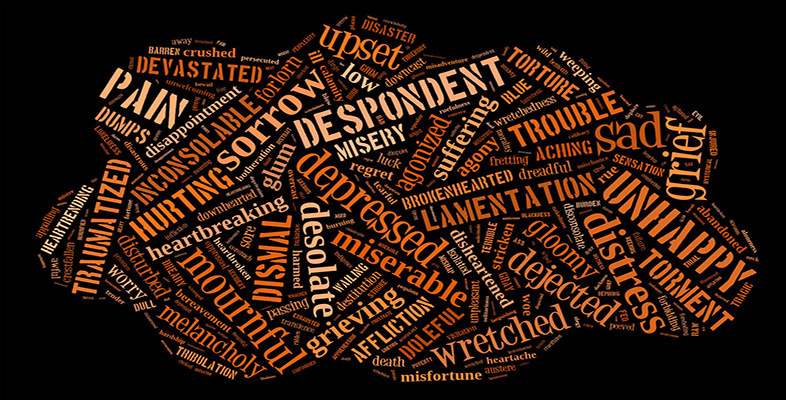2.2 Identifying emotions
The question ‘What is an emotion?’ is a question about emotions in general. But it is impossible to address this question without being aware that there appear to be many different types of emotion. One way to start is to consider a range of states and to identify which states we would naturally classify as emotions, and which we would naturally classify as states of some other kind. This will put us in a better position to see whether there are any common features that link different types of emotions and differentiate them from states of other kinds. At this stage, we are relying on our everyday, unreflective conception of what counts as an emotion: but we are not committed to the view that our initial classification is completely uncontroversial, or that it is immune to revision in the light of further reflection.
Activity 1
Look through the following list:
| anger | nausea |
| hunger | love |
| fear | disgust |
| jealousy | cowardice |
| being startled | joy |
| feeling cheerful | nostalgia |
| sadness |
Divide the items on the list into three categories:
States or occurrences that you think are emotions.
States or occurrences that you think are not emotions, but something else. In this case, note down what sorts of state you think these might be. For example, you might prefer to categorise some of these as moods or as bodily feelings, rather than emotions.
States or occurrences that you are uncertain about.
Discussion
There is no agreed way to divide up the items on the list. But just about everyone would regard anger and fear as emotions. For that reason, I shall use them as examples throughout this discussion. Sadness, joy and disgust are also fairly uncontroversial instances of emotion.
In contrast, most people would deny that hunger and nausea are emotions. They seem to be sensations or feelings caused by changes occurring in the body. In what follows, I shall refer to sensations of this kind as ‘bodily feelings’; bodily feelings need to be distinguished from the bodily changes that generate them: to experience a bodily feeling is to feel some change occurring in one's body. The distinction between bodily feelings and emotions is not altogether clear cut. Emotions do seem to involve bodily feelings: we say that someone feels a stab of fear, a surge of anger, or a flutter of joy. This might make us wonder how nausea differs from disgust.
On the face of it, being startled does not look like an emotion. It seems to be a reflex action: a sudden noise or movement triggers a stereotypical response, including a characteristic facial expression and a change in posture. But the startle response has some important features in common with states that we would naturally classify as emotions. In particular, some emotional responses – changes in facial expression, for example – are quick and involuntary in the way that the startle response is. Jennifer Robinson argues that we should view startle as a very primitive kind of emotion – a precursor of fear or surprise (Robinson 1995). If you do not agree, you might ask yourself why: in what way does the startle response differ from an emotion?
There appears to be a distinction between emotions and moods. But the precise nature of this distinction is unclear. Moods involve feelings that are similar to emotional feelings in important ways. But we typically characterise moods as lasting longer than emotions. Moreover, moods do not focus on a specific object or event in the way that emotions seem to do. If I am in an angry mood, I tend to get angry at anything and anyone. If this is right, it would seem appropriate to treat feeling cheerful as a mood rather than an emotion: when someone is feeling cheerful, they tend to feel happy about everything that is going on around them.
The distinction between a character trait and an emotion seems rather clearer. A character trait is a settled tendency to respond to certain situations with certain emotions or a tendency give into a certain emotion when it is not justified or appropriate to do so. Most people would regard cowardice as a character trait rather than an emotion.
Love might be regarded as a standard case of emotion. But it can be argued that love is not an emotion, but what has been termed an emotional attitude: that is, a tendency to feel different emotions about, for example, a certain person, depending on the circumstances – you might feel pride if a loved person has some success, fear or anger if they are threatened, sadness if they die.
Again, jealousy looks like a paradigm case of emotion. It is worth bearing in mind, though, that jealousy can also be the name of a character trait. Moreover, it might be suggested that jealousy is not an emotion in its own right, but a complex of fear and anger felt in response to the infidelity or perceived infidelity of another person. A similar suggestion might be made about nostalgia. We might regard nostalgia as an emotion in its own right or we might regard it as a mix of emotions, involving sadness and pleasure, felt in the context of certain kinds of thought about the past.
Emotions, then, might be distinguished from bodily feelings, reflex responses, moods, character traits and perhaps more complex states involving a number of emotions. But it is not always easy to identify the source of these contrasts.
